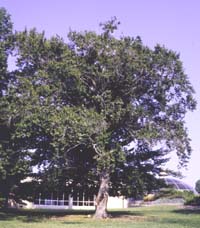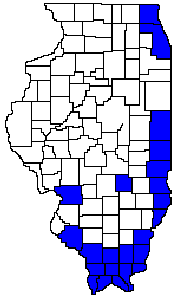 |
| Beech
(Fagus grandifolia)
Distribution
Map to Right |

Beech trees are tall, up to 100 feet in height, and up to 4 feet in diameter. The crown is wide and spreading. They prefer moist sites, usually rich mesic forests. Distinctive features of the beech tree include very smooth, gray bark and long and slender winter buds that have many scales.
Interesting
Facts,
The smooth, gray bark of the Beech is often disfigured by human carving ("Beth loves John", and so on). Although it is an important timber tree, Beech is used mainly in the production of inexpensive furniture, tool handles, etc. The leaves are very attractive yellowish, blue-green in the early spring.
Identifying Features
Bark
The bark is smooth and gray.
Leaves
The leaves are alternate, simple, and egg-shaped with coarse-toothed edges. They are up to 4 inches in length and half as wide, with pointed tips. Early in the spring, when the leaves first appear, they are yellow-green, contrasting sharply with the smooth gray bark. The mature leaves are blue-green to green and smooth on the upper surface and slightly hairy on the lower surface.
Flowers
Male and female flowers are born separately on the same tree (moneocious), and appear after leaf out.
Fruits
The fruits are small and burr-like in appearance. They are less than an inch long, brown, and contain one or several nuts that are consumed by ruffed grouse, wild turkey, bobwhite, pheasant, raccoon, fox, rabbits, deer, and squirrels.
Uses
The wood
is hard and close grained. Though the quality is only fair, beech wood
is used for furniture, tool handles, veneer, fence posts, and fuel. The
tree is often planted as an ornamental for its great beauty. Native Americans
used concoctions made from various parts of beech to treat tuberculosis,
heart ailments, worms, burns and scalds, and to treat cases of poison ivy,
among other things.